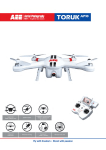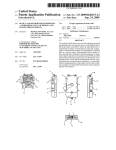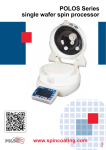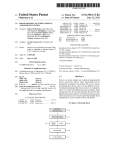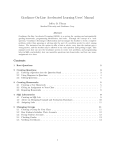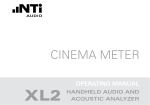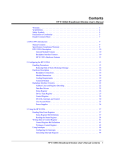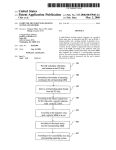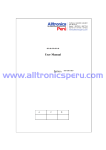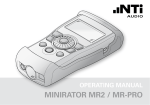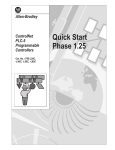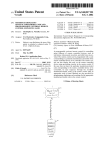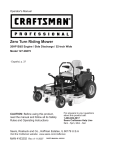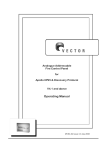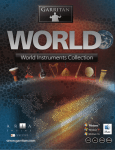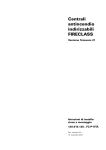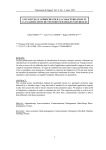Download Automatic supervised classifier setup tool for semiconductor defects
Transcript
US007359544B2
(12)
(54)
United States Patent
(10) Patent N0.:
Gao et a].
(45) Date of Patent:
5,440,649 A *
5,991,699 A
DEFECTS
6,104,835 A
6,233,719 B1*
8/2000
5/2001
6,408,219 B2:
6/2002 Lamey et a1.
6,456,951 B1
9/2002 Maeda et al.- ............... .. 702/81
B0 Magluyan LOS Gatos CA
_
_
6,473,665 B2*
Jlanf‘ln Zhang’ Santa Clara’ CA (Us),
Kevlll Yeung, SWIM/ale, CA (Us);
Kenong W11, Davls, CA (US); Tong
_
’
’
’
6,597,381 B1 *
6,910,035 B2*
6,913,466 132*
Huang, San Jose, CA (US)
Notice:
WO
Subject to any disclaimer, the term of this
* Cited by eXaminer
gage? 11S STE]???$1990; gaijlgsted under 35
'
'
y
..
(22) Filed:
(60)
(51)
(52)
WO01/40145 A2
(57)
Prior Publication Data
7/2001
ABSTRACT
Disclosed are methods and apparatus for e?iciently setting
up and maintaining a defect classi?cation system. In general
Aug. 12, 2004
terms, the setup procedure optionally includes automatically
grouping a set of provided defects and presenting a repre
sentative set from each defect group to the user for classi
?cation. After the initial manual classi?cation of the repre
Related U-s- Application Data
Provisional application NO 60/ 4 47 360 ?led on Feb‘
12 2003'
’
’
’
Int_ CL
sentative defects, the setup procedure includes an automatic
procedure for classifying the non-reviewed or unclassi?ed
defects based on the manual class codes from the user
G06K 9/00
G06K 9/62
reviewed defects. After the automatic classi?cation opera
tion, the user may also be presented With defects from each
(200601)
(200601)
us. Cl. ..................................... .. 382/145- 382/224
(58) Field of Classi?cation Search
See a
(56)
Muglbayashl et a1. .... .. 700/110
7/2003 Eskridge et a1. .......... .. 715/804
6/2005 Hoekman et a1. ......... .. 707/4
7/2005 Stan?eld et a1. ..
434/219
(74) Attorney, Agent, or FirmiBeyer Weaver LLP
Nov. 13, 2003
US 2004/0156540 A1
700/110
Assistant ExamineriHadi Akhavannik
,
(65)
.. 382/225
.... .. 716/1
Primary ExamineriBhavesh M Mehta
y '
Appl NO _ 10/713 628
.
10/2002
Han ............... ..
Hardikar et a1. ..
FOREIGN PATENT DOCUMENTS
Corporation, Milpitas’ CA (Us)
'
8/1995 Kiyasu et a1. ............ .. 382/147
11/1999 Kulkarni et a1. ..
702/83
2002/0159643 A1* 10/2002 DeYong et a1. ........... .. 382/228
(73) Assignee: KLA-Tencor Technologies
(21)
Apr. 15, 2008
AUTOMATIC SUPERVISED CLASSIFIER
SETUP TOOL FOR SEMICONDUCTOR
(75) Inventors: Lisheng Gao’ Morgan Hill’ CA (Us);
(*)
US 7,359,544 B2
Class which may require reclassi?cation In Particular
382h41i153
embodiments, the user is iteratively presented With defects
lication ?le for Com leté's'ée'l'r'ch histo
pp
p
ry'
References Cited
Which have classi?cations that are suspect, Which are near
classi?cation boundaries, or have classi?cations that have a
loW con?dence level until each class is pure or contains a
same type of defect classes as assigned by the user.
US. PATENT DOCUMENTS
5,325,445 A *
6/1994
44 Claims, 11 Drawing Sheets
Herbert .................... .. 382/225
Group detects and
present a
representative set 61
defects imm eecii
gmup w a \ISBrfDY
l
Tune classi?cation by
ileratively presenting
iepiewmaiive defects
in user for
Use classi?ed defeds
as a reference in
detect new type! in
detecie in other non
relerence detects
Usa training set as
a I’B'BVBHOB In
detect new types a!
defem in other
non-reference
defect:
Create
classl?el
Group new
typas 0!
Meals a N1
manualry
cieeeiiy them
U.S. Patent
Apr. 15, 2008
Sheet 1 0f 11
US 7,359,544 B2
100
Provide
/\_1jJ 1
defect data
1
1
‘
Review
defects
Group defects and
present a
104
representative set of
defects from each
group to a user for
classi?cation
14
105
4/
Tune
classi?cation by
iteratively presenting
_
useasc'assf'?ed
deftects
a re erence o
representative defects :1
to user for
defects m other non-
classi?cation
reference defects
~
resent?) Se
p
120
'
112
116
N
a Trainin
detect new types of
Create classi?er?
1 Use training set as
a reference to
=
122
A
detect new types of
defects in other
y new defec <
found’?
N
non-reference
defects
118
A)
Group new
types of
defects and
manuall
classifythgm
1
U.S. Patent
Apr. 15, 2008
Sheet 2 0f 11
US 7,359,544 B2
104
/
Automatically group defects into
a selected number of groups
/502
Present representative/seed
defects from each group to user
for manual classi?cation
Add manually classifed defects
into seed set
FIG. 2
A310
U.S. Patent
Apr. 15, 2008
Sheet 3 0f 11
US 7,359,544 B2
U.S. Patent
Apr. 15, 2008
Sheet 4 0f 11
US 7,359,544 B2
350
360
FIG. 3B
U.S. Patent
Apr. 15, 2008
US 7,359,544 B2
Sheet 5 0f 11
FIG. 4
105
/
Seed set includes manually
classi?ed defects
Modify
Automatically determined a
probable class for non-reviewed
assigned to seed defects
l
l
number if
changed
M2
defects based on class codes
changed
Update class
l
A1522
manual code
of seed
defects if
A"
A4324
Present representative defects
with lowest con?dence levels
404
from each probable class to user
for possible re-classi?cation
l
Add newly
classi?ed
defects into
seed set
‘
- all probable clas >~
pure?
Add newly classi?ed
416
defects to seed set
V
Present suspected misclassifed defects to
user for possible re-classi?cation and add
to seed set
l
Assign class codes to non-reviewed
defects based on manually assigned
class codes of each probable class.
‘
(
Done
)
418
U.S. Patent
Apr. 15, 2008
Sheet 6 0f 11
US 7,359,544 B2
Cre
, ,1; $5,, v .
.
502
Piease
d“
504
504
504
U.S. Patent
Apr. 15, 2008
US 7,359,544 B2
Sheet 7 0f 11
Classifier
Creation
122
/
601
0 manual codes
exist?
Supervised mode’?
Use existing
Issue warning that
manual classes
and training set will
be lost
Execute Manual
Classification Process
(102 of Fig. 1)
616
‘
N613
Create training set for
Automatically
classi?er based on
group defects into
implementing max/
groups and assign
min procedure on
classi?ed defects
unique class code
Determine and
present information
regarding accuracy
and purity of 3
608
‘
Determine and
present information
614
regarding accuracy ~/\/
and purity of existing
classifiers
classi?cation
r
609
User selects one of 3
classi?ers
FIG. 6
each group a
U.S. Patent
Apr. 15, 2008
Sheet 8 0f 11
US 7,359,544 B2
Classi?er Accuracy & Purity
02
06
FIG. 7
U.S. Patent
Apr. 15, 2008
Sheet 9 0f 11
Classi?er Accuracy 81 Purity
60.0
.1000 89.0‘
FIG. 8
0110
US 7,359,544 B2
U S. Patent
35.B8Ew:201
mm23c1o.zmuéw;!3i
Apr. 15, 2008
Sheet 10 0f 11
US 7,359,544 B2
U.S. Patent
Apr. 15, 2008
Sheet 11 0f 11
US 7,359,544 B2
Column 1020
C01n6go6ler
Detector
System //
1032
lnterferometers
1028
Sample 1057
Stage 1024
Stage Servo 1026
Sample Handler
1034
FIG. 10
US 7,359,544 B2
1
2
AUTOMATIC SUPERVISED CLASSIFIER
SETUP TOOL FOR SEMICONDUCTOR
DEFECTS
SUMMARY OF THE INVENTION
Accordingly, mechanisms are provided for ef?ciently
setting up and maintaining a defect classi?cation system. In
CROSS REFERENCE TO RELATED
APPLICATIONS
general terms, the setup procedure optionally includes auto
matically grouping a set of provided defects (e.g., defect
images) and presenting a representative set from each defect
group to the user for classi?cation. Alternatively, a repre
This application claims priority of US. Provisional Appli
sentative set from the Whole defect set may be presented to
the user for classi?cation Without ?rst grouping the defects
into groups. The representative set does not include all of the
defects and is selected to optimiZe manual classi?cation
ef?ciency. After the initial manual classi?cation of the
cation No. 60/447,360, ?led on 12 Feb. 2003, Which appli
cation is herein incorporated by reference in its entirety for
all purposes.
BACKGROUND OF THE INVENTION
representative defects, the setup procedure includes an auto
matic procedure for classifying the non-revieWed or unclas
The present invention relates generally to inspection of
si?ed defects based on the manual class codes from the
user-revieWed defects. After the automatic classi?cation
operation, the user may also be presented With defects from
semiconductor devices, such as test structures and other
types of semiconductor structures. More speci?cally, it
relates to techniques for classifying defects found on inte
grated circuit devices.
Semiconductor defects may include structural ?aWs,
residual process material and other surface contamination
Which occur during the production of semiconductor Wafers.
Defects are typically detected by a class of instruments
called inspection tools. Such instruments automatically scan
Wafer surfaces and detect, and record the location of anoma
20
Which have classi?cations that are suspect, Which are near
classi?cation boundaries, or have classi?cations that have a
loW con?dence level until each class is pure or contains a
25
defects. Defect image data is provided, e.g., from an defect
30
classi?cation. The representative set of defects from each
classi?es each defect according to class (e.g., particle, pit,
scratch, or contaminant). Information gained from this pro
revieW system. The defect image data is then grouped (e.g.,
using a natural grouping procedure) into a plurality of
groups of one or more defects. A representative set of defects
from each group is then determined so as to optimiZe manual
Using the defect map to locate each defect, a human
operator observes each defect under a microscope and
cess is used to correct the source of defects, and thereby
same type of defect classes as assigned by the user.
In one embodiment, a method of setting up an automatic
defect classi?er system for classifying semiconductor
lies using a variety of techniques. This information, or
“defect map,” is stored in a computer ?le and sent to a defect
revieW station.
each class Which may require re-classi?cation. In particular
embodiments, the user is iteratively presented With defects
35
group and not the defects Which are not part of the repre
sentative set from each group are then presented to a user for
manual classi?cation. The defects Which are not part of the
improve the ef?ciency and yield of the semiconductor
representative set from each group are de?ned as non
production process. Problems With this classi?cation method
include the technician’s subjectivity in identifying the defect
revieWed defects.
class, and the fatigue associated With the highly repetitive
task of observing and classifying these defects.
40
non-revieWed defect based on the manual classi?cations by
Methods of automatically classifying defects, collectively
the user (e.g., using a nearest neighbor procedure); (b)
determining a representative set of defects from each prob
able class Which include defects having a probable class
knoWn as Automatic Defect Classi?cation or “ADC,” have
been developed to overcome the disadvantages of manual
defect classi?cation. A conventional ADC system uses
image processing techniques to ?rst detect the defect and
then to classify the defect according to the defect’s physical
characteristics and background geometry. Comparing these
physical characteristics to the physical characteristics of
pre-classi?ed defects in a training set permits automated
defect classi?cation.
45
(d) repeating steps (a) through (c) until all defects Within the
representative set of defects from each probable class have
50
While this system reduces technician fatigue and
time once the training set has been generated, such training
55
?cation for some defects. The setup of the training set
typically is time consuming because it requires the manual
classi?cation of thousands of defects. During this manual
classi?cation process, the user is often presented With thou
sands of substantially similar defects Which require indi
With a loWest con?dence level Within such probable class;
(c) presenting the representative set of defects from each
probably class to the user for possible re-classi?cation; and
increases the number of defects that can be classi?ed per unit
set programs sometimes fail to provide an accurate classi
In a further embodiment, the folloWing method operations
are performed: (a) determining a probable class for each
60
a same class, Wherein the repetition of the determination of
the probable class is based on the manual classi?cations and
the re-classi?cation by the user.
In another aspect, it is determined Whether manual clas
si?cation is present already for some of the defects, and the
defects are grouped and the representative sets are presented
only When there is no manual classi?cation present. In one
aspect, each representative set of defects is a manageable
subset of defects from group’s total defects. In another
aspect, determining the representative set of defects for each
group includes selecting only a single defect from among
vidual manual classi?cation. Needless to say, this process
defects Which are substantially similar to be included Within
requires a signi?cant amount of man-hours for a user to set
the representative set for such group. In another implemen
tation, determining the representative set of defects for each
group includes selecting defects Which are uniformly dis
tributed among the group’s defects to be included Within the
representative set for such group. In yet another aspect,
determining the representative set of defects for each group
up the training set.
Accordingly, there is a need for improved mechanisms for
more ef?ciently setting up an automatic defect classi?cation
system. Additionally, there is a need for optimiZing and
ef?ciently maintaining an existing classi?cation system.
65
US 7,359,544 B2
3
4
includes selecting defects which are the most diverse from
product con?gured to perform one or more of the above
the group’s defects to be included within the representative
described inventive procedures.
These and other features and advantages of the present
set for such group.
In yet another implementation, determining the represen
invention will be presented in more detail in the following
speci?cation of the invention and the accompanying ?gures
which illustrate by way of example the principles of the
tative set of defects for each group includes (1) when the
defects for the each group total less than three, selecting all
of the defects from the each group to be included within the
representative set for such group; and (2) when the defects
for the each group are equal to three or more, selecting
defects based on the max/min algorithm until 1A of the
invention.
BRIEF DESCRIPTION OF THE DRAWINGS
FIG. 1 is a ?owchart illustrating a procedure for increas
defects from the each group are selected.
ing the e?iciency of manual classi?cation in setting up a
In a further aspect, determining the representative set of
defects from each probable class includes (1) determining a
con?dence level for each non-reviewed defect in each
classi?cation system in accordance with one embodiment of
the present invention.
FIG. 2 is a ?owchart illustrating the operation of FIG. 1
probable class; and (2) selecting the non-reviewed defects
for grouping defects and presenting representative defects
from each probable class which have the lowest con?dence
level for inclusion in the representative set for such probable
class. In a speci?c implementation, the con?dence level for
each non-reviewed defect within each probable class is
from each group to a user for manual classi?cation in
accordance with embodiment of the present invention.
equal to a minimum distance between the each non-re
viewed defect and two of the nearest classi?ed defects
divided by a maximum distance between the each non
reviewed defect and two of the nearest classi?ed defects.
In a further embodiment, when there is manual classi?
20
cation present the method includes the operations (I) when
25
FIG. 3A is a screen shot showing representative sets of
defects from a selected number of groups.
FIG. 3B illustrates the application of the max/min algo
rithm to a plurality of defects in a particular group in order
to select a representative set of defects from such group in
accordance with one embodiment of the present invention.
there is a training set present, using the training set as a
reference to detect new defects in other unclassi?ed defects;
FIG. 4 is ?owchart illustrating the operation of FIG. 1 for
tuning the seed set of classi?ed defects in accordance with
one embodiment of the present invention.
(2) when there is not a training set present, using the
FIG. 5 illustrates a screen shot showing an example set of
classi?ed defects as reference defects to detect new defects
probably classes (or “probable bins”) each having a set of
representative defects presented to the user for possible
from other unclassi?ed defects; (3) when new defects are
found, grouping the new defects and presenting to the user
for classi?cation; and (4) when new defects are found,
30
reclassi?cation.
FIG. 6 is a ?owchart illustrating a procedure for creating
a classi?er in accordance with one embodiment of the
repeating operations (a) through (c) after the new defects are
classi?ed.
In another embodiment, a classi?er system for classifying
present invention.
35
FIG. 7 illustrates accuracy and purity matrices for an
unclassi?ed defects is created when the user selects an
example (1) classi?er based on the existing training set, (2)
option for creating the classi?er system. Creating the clas
si?er system is accomplished by repeating the operations for
grouping, presenting the representative set from each group;
and operations (a) through (c). The classi?ed defects are
a classi?er based on a training set selected using the max/
min algorithm (3) a classi?er based on a training set com
bining the existing training set and a training set selected
40
using the max/min algorithm.
as part of the classi?er system, when the user selects a
FIG. 8 is a screen shot of an accuracy and purity matrix
for a classi?er created based on a training set selected using
supervisor mode. Creating the classi?er further includes
the max/min algorithm.
used as reference defects for classifying unclassi?ed defects
using at least a portion of the classi?ed defects as reference
defects for classifying unclassi?ed defects as part of the
classi?er system when the user selects an existing manual
45
selected using the max/min algorithm with the manual class
codes assigned by natural grouping algorithm.
classi?cation mode and using a grouping procedure for
classifying unclassi?ed defects as part of the classi?er
system when the user selects an unsupervised mode.
In a further aspect, when the existing manual classi?ca
tion mode is selected, purity and accuracy matrices for a
classi?er are presented based on (1) an existing training set,
FIG. 9 is a screen shot of an accuracy and purity matrix
for an example of a classi?er created based on a training set
FIG. 10 is a diagrammatic representation of a defect
50
image analysis system in accordance with one embodiment
of the present invention.
DETAILED DESCRIPTION OF SPECIFIC
EMBODIMENTS
(2) a training set selected using the max/min algorithm (3)
a training set combining the existing training set and a
training set selected using the max/min algorithm. A clas
55
system for classifying semiconductor defects data. The
60
more memory. In yet another aspect, the invention pertains
to a computer program product for setting up an automatic
defect classi?er system for classifying semiconductor
tions stored within the at least one computer readable
limit the invention to one embodiment. On the contrary, it is
intended to cover alternatives, modi?cations, and equiva
lents as may be included within the spirit and scope of the
invention as de?ned by the appended claims. In the follow
ing description, numerous speci?c details are set forth in
computer system includes one or more processors and one or
defects. The computer program product includes at least one
computer readable medium and computer program instruc
Reference will now be made in detail to a speci?c
embodiment of the invention. An example of this embodi
ment is illustrated in the accompanying drawings. While the
invention will be described in conjunction with this speci?c
embodiment, it will be understood that it is not intended to
si?er is then created based on the user’s selected from
among the three classi?ers.
In another aspect, the invention pertains to a computer
system operable to set up an automatic defect classi?er
65
order to provide a thorough understanding of the present
invention. The present invention may be practiced without
some or all of these speci?c details. In other instances, well
US 7,359,544 B2
5
6
known process operations have not been described in detail
in order not to unnecessarily obscure the present invention.
FIG. 1 is a ?owchart illustrating a procedure 100 for
selecting a particular number, and a set of buttons for
selecting from a plurality of ?xed numbers. In the illustrated
embodiment, the total number of groups 302 is set to ?ve by
slider 302.
Representative defects from each group are presented to
the user. Viewing the representative defects, the user may
continue to adjust the total group number until he/she is
satis?ed that the presented defects are divided among a
correct number of groups. For example, when each group
has similar types of defects, the user may determine that
total group number is set correctly. Otherwise, when one or
more groups contain signi?cantly differing defect types, the
user may adjust the total group number. In the illustrated
increasing the e?iciency of manual classi?cation in setting
up a classi?cation system in accordance with one embodi
ment of the present invention. Initially, defect data is pro
vided in operation 101. Defect data is typically provided in
the form of images obtained from a high resolution review
tool, such as an electron microscope. One example of a
review tool is the eV300 E-beam Defect Review tool
available from KLA-Tencor of San Jose, Calif. Typically, a
semiconductor product, such as a product wafer or test wafer
(or a device), is inspected for defects and a defect map is
provided. The defect map is then used to obtain a high
example, group1 30411 has 10 representative defects having
resolution image of each located defect, e.g., using the
a similar appearance; group2 30419 has 9 representative
defects having a similar appearance; group3 3040 has 10
representative defects having a similar appearance; and
group4 304d has 8 representative defects having a similar
appearance (group5 is not visible and may be seen by
review tool.
After defect image data is provided, it may then be
determined whether there are any manual class codes
present in operation 102. In other words, it is determined
whether a user has already manually classi?ed a set of
defects. If there are no manual class codes, a manual
20
classi?cation procedure will then be initiated in combination
with an automatic process to increase the e?iciency of such
manual classi?cation procedure. In general terms, tech
niques are provided so as to help a user e?iciently classify
a manageable subset of defects. First, the defects may be
25
automatically grouped and a representative set of defects
from each group is presented to a user for classi?cation in
operation 104. However, this grouping operation is optional
and may be skipped. Alternatively, a representative set from
30
the whole defect set may be presented to the user for
classi?cation without ?rst grouping the defects into groups.
scrolling down).
The representative defects generally include a minimum
set of defects that require user classi?cation. For instance,
when there is a plurality of nearly identical defects within a
group, a single defect from this identical set is selected to be
included in the representative set for such group. Addition
ally, boundary defects or the most different defects within a
group are typically selected as part of the representative set.
Any suitable algorithm may be used to determine the
representative defects for each group presented to the user
for classi?cation. The algorithm is selected to present a
non-redundant and diverse set of defects for each group that
FIG. 2 is a ?owchart illustrating the operation 104 of FIG.
maximizes diversity (i.e., presents the most diverse set of
defects for each group). The representative set may also be
1 for grouping defects and presenting representative defects
selected to include defects which are uniformly distributed
from each group to a user for manual classi?cation in 35 among the group’s defects. In a speci?c implementation, the
accordance with embodiment of the present invention. Ini
tially, the defects are automatically grouped into a selected
number of groups in operation 202. In the illustrated
embodiment, the user may select the number of groups.
Alternatively, the number of groups may be pre-de?ned.
Representative or seed defects are then presented from each
following algorithm is used to select the representative set
40
group to the user for manual classi?cation in operation 204.
for each group:
(i) If the defect number for the group is less than 3, select
all defects from such group;
(ii) the maximum number of defects to be selected must
be less than 10 defects for the group;
(iii) select defects based on the following formula if
Any suitable grouping technique may be implemented to
condition (i) has not been met and (until condition (ii) has
group or cluster similar defects. Several grouping techniques
are further described in Us. Pat. No. 5,991,699 by Ashok V.
Kulkami et al. issued 23 Nov. 1999 and International Appli
cation No. PCT/USOO/ 32635 ?led 29 Nov. 2000 published 7
Jun. 2001, which are both incorporate herein by reference in
their entirety for all purposes.
In one example implementation, a natural grouping pro
cedure or algorithm may be implemented to group the
been reached or until 1A of the defects for such group has
45 been selected: max{min(dl, . . . dn)}for all defects n, where
d is the distance between a defect that has yet not been
selected as a representative defect and a representative
defect, (herein referred to as the “max/min algorithm”).
FIG. 3B illustrates the application of the max/min algo
50
defects into a selected or prede?ned number of groups. A
natural grouping algorithm typically includes ?rst obtaining
the defect that is located a farthest distance (in feature space)
a feature vector for each defect image. The feature vector
may include any suitable number and type of quanti?able
image characteristics, such as defect shape, defect siZe,
defect intensity, background intensity, etc. The feature vec
tors are then plotted in N-dimensional space (where N is the
number of vector parameters) and spatially clustered or
grouped based on each vectors relative position in such
space.
FIG. 3A is a screen shot showing a representative sets of
defects 304 from a selected number of groups (Groups 1~5
are shown). The user may select or adjust the total number
of groups by any suitable mechanism such as the illustrated
slide bar 302. Other common input device types include an
entry box for entering a speci?c number, a dial or knob for
rithm to a plurality of defects in a particular group 352 in
order to select a representative set of defects from such
group in accordance with one embodiment of the present
invention. Initially, a random defect 354 is selected. Next,
55
60
65
from the initial defect 354 is selected as a representative
defect. As shown, defect 366 is the defect located the farthest
from the initial defect 354. The initial defect 354 is then
thrown out and not used in the representative set (at least
initially). A second defect that is located the farthest distance
from the ?rst representative defect 366 is then selected. In
the illustrated example, defect 368 is the second represen
tative defect.
The next defect which has the maximum minimum of the
two distances to the two representative defects is next
selected as part of the representative set. As shown, defect
360 is located a distance d1 from representative defect 368
and a distance d2 from representative defect 366. Likewise,
US 7,359,544 B2
7
8
defect 356 is located a distance d1 from representative
defect 368 and a distance d2 from representative defect 366.
Defect 364 is located a distance d1 from representative
defect 368 and a distance d2 from representative defect 366.
terms, the boundary defects from each probable class are
presented for possible re-classi?cation. In a speci?c imple
mentation, the following algorithm is used to determine the
con?dence level of each classi?ed defect and the ?ve defects
having the lowest con?dence value are then selected:
For each potential representative defect, a minimum dis
tance (d1 or d2) is determined. The minimum distance for
defect 360 is d1; the minimum distance for 356 is d1, and the
minimum distance for defect 364 is d1 in the illustrated
(herein referred to as the
confidence value = l — —
example. Out of these three potential representative defects
d2
360, 356, and 364, defect 364 has the maximum minimum
distance (d1). That is, the minimum distance d1 for defect
364 (to representative defect 366) is greater than both the
minimum distance d1 for defect 360 (to representative
defect 368) and the minimum distance d1 for defect 356 (to
where dl represents the distance between the unknown
defect and its nearest seed defect DS and d2 represents the
distance between the unknown defect and its second nearest
seed defect which has a different manual code than the seed
representative defect 368). Accordingly, defect 364 is cho
defect DS.
sen as the third representative defect. The defect which has
the maximum minimum distance to these three representa
tive defects is then selected as the next representative defect
(e.g., defect 360), and this process is repeated until a 1A of
the group defects are selected or the maximum of 10 is
reached.
In another technique, one may select the representative
defects for a relatively tightly clustered group to include a
defect in the center of the group and defects distributed
along the outside border of the group at regular intervals. In
“confidence algorithm")
FIG. 5 illustrates a screen shot showing an example set of
20
probably classes (or “probable bins”) 502 each having a set
of representative defects presented to the user for possible
reclassi?cation. Any suitable input mechanism may be uti
liZed to allow the user to reclassify the representative set of
defects from each probable class. As shown in FIG. 5, the
user interface includes a set of class identi?ers 504, along
with images of the representative defects from each probable
25
class 502. Alternatively, the user may be sequentially pre
more loosely clustered groups, one may select defects
sented with each probable group’s representative defects for
through the interior space which are evenly distributed at
regular intervals from the center to the outside boundary.
The intervals may be determined through experimentation to
30
possible re-classi?cation. The user may reclassify any of the
represented defects 502 by selecting a new class 504 for any
of defects 502. In a speci?c implementation, the user may
select all or a portion from each probably bin 502 for
determine which interval values lead to more accurate
placement into a particular class by selecting, dragging, and
dropping the defects into the appropriate class identi?er 504.
classi?cation schemes.
Referring back to FIG. 2, after manual classi?cation, the
manually classi?ed defects are then added into a seed set in
operation 210. The seed set is later used to tune the classi
?cation scheme of the defects as described further below.
After the representative defects from each group are
The user may also change the number of classes by setting
up a new class identi?er.
35
The illustrated interface for re-classifying representative
manually classi?ed by the user, the classi?cation is then
defects from probable classes is not meant to limit the scope
of the invention. Other types of interfaces are also contem
tuned by iteratively presenting representative defects to the
plated. In another example, the interface may simply include
user for classi?cation in operation 105 of FIG. 1. The initial
set of manually classi?ed defects (e.g., obtained in operation
40
210 of FIG. 2) is used as the initial seed set. This seed set
of classi?ed defects is generally adjusted until it can be used
to a class code equal to “2.”
Referring back to FIG. 4, after the user reclassi?es as
to automatically and accurately classify other defects which
have not been reviewed and manually classi?ed by the user.
FIG. 4 is ?owchart illustrating the operation 105 of FIG.
1 for tuning the seed set of classi?ed defects in accordance
with one embodiment of the present invention. In operation
45
necessary, it is then determined whether all probable classes
50
are still pure in operation 408. If the probable classes are not
pure, the newly classi?ed defects are then added into the
seed set in operation 426. That is, when the classes contain
all the same class of manually classi?ed defects, the class is
deemed to be pure. The class number may also be updated,
401, the seed set initially includes the manually classi?ed
defects. The non-reviewed defects which have not been
manually classi?ed are automatically divided into a plurality
of probable classes based on the class codes manually
assigned to the seed set defects in operation 402. Any
suitable procedure may be implemented to classify defects
based on an initial classi?ed seed set of defects. For
example, a neural net procedure or algorithm may be imple
mented.
55
By way of another example, a nearest neighbor procedure
or algorithm may be utiliZed. In general terms, an unknown
input image is assigned a classi?cation code equal to a defect
having the most similar feature vector within the feature
space. Several nearest neighbor embodiments are further
described in Us. Pat. No. 6,104,835 by Ke Han issued 15
e.g., if changed by the user in operation 424. The manual
class code of the seed defects may also be modi?ed, e.g., if
changed by the user, in operation 422. Probable classes may
then be automatically determined again for the new seed
defects and a representative set from each probably class is
presented to the user for possible reclassi?cation in opera
tions 402 and 404, respectively. These two operations are
repeated until all the probable classes are determined to be
pure.
60
When all probable classes are pure, the newly classi?ed
defects are then added to the seed set in operation 416.
Suspected misclassi?ed defects are then presented to the
user for possible re-classi?cation in added to the seed set in
Aug. 2000, which patent is incorporated herein by reference
in its entirety for all purposes.
Representative defects having the lowest con?dence lev
an entry box for each defect in which the user may change
the determined probable class code. For instance, a defect
may be proximate to an entry box having a probable class
code equal to “l”, and the user may change this class code
operation 418. In one implementation, defect classi?cations
els are then presented from each probable class to the user
which have a con?dence level below a predetermined value
are de?ned as suspected misclassi?ed defects. Class codes
for possible re-classi?cation in operation 404. In general
are then assigned to non-reviewed defects based on manu
65
US 7,359,544 B2
9
10
ally assigned class codes of each probable class in operation
420 and the tuning procedure ends.
conventional methods or may have been created using the
example, the user may be presented With the option of
creating a classi?er (e.g., a classi?er creation input button).
manual classi?cation and training set formation techniques
of the present invention. If a training set is present, purity
and accuracy data is determined and presented for three
different classi?ers in operation 608. The purity and accu
racy data is generally determined by comparing training set
defects to manually classi?ed defects. As shoWn in FIG. 7,
If a classi?er is not to be created, the procedure 100 ends. If
a classi?er is to be created, a classi?er is created in operation
an accuracy and purity matrix is shoWn for a classi?er based
on the existing training set (702), a classi?er based on
122. This classi?er creation operation 122 generally
training set selected through max/min algorithm (706), and
Referring back to FIG. 1, after the setup of the classi?
cation system is tuned, it may then be determined Whether
the user Wishes to create a classi?er in operation 120. For
includes creating a classi?er based on one or more portions
a classi?er based on a training set combining the existing
of the manually classi?ed defects and maintaining such
classi?er, Which is described further beloW. The procedure
training set and training set selected from max/min algo
rithm (704). The user may then select the particular classi?er
to be used in operation 609.
100 then ends.
Referring back to operation 102 of FIG. 1, if there are
HoWever, if there are no manual codes present, it is then
manual class codes already present, the defects may then be
revieWed in operation 106, instead of proceeding through a
manual classi?cation process (operations 104 and 105). The
user may then determine Whether to reset the manual class
codes in operation 108. If the manual class codes are to be
20
reset, the procedure 100 goes to operation 104, Where the
defects are grouped again for user classi?cation.
If the manual class codes are not to be reset, it is then
determined Whether a training set is present in operation 110.
If a training set is already present, the training set may be
the max/min procedure on the classi?ed defects. The user is
25
used as a reference to detect neW types of defects in other
non-reference defects in operation 112. If a training set is not
present, the classi?ed defects may be used as a reference to
detect neW defects in other non-reference defects in opera
tion 114. In either case, it may then be determined Whether
neW defects have been found in operation 116. If neW
30
35
each group is assigned a unique class code in operation 616.
40
(i) A training set T and a defect set V (maybe from a neW
Wafer) are provided;
45
(iii) Let r:dv/dt.
A training set may then be formed based on the classi?ed
defects or by using the max/min procedure on the classi?ed
defects. The user may then be presented With an accuracy
and purity matrix for the unsupervised classi?er. FIG. 9 is a
screen shot of an accuracy and purity matrix for an example
of a classi?er created based on a training set selected using
the max/min algorithm With the manual class codes assigned
by natural grouping algorithm.
Referring back to operation 610, if neW defects need to be
(iv) If dt>t1 and r<t2, Where t1 and t2 are prede?ned ?xed
classi?ed, the manual classi?cation process (operation of
FIG. 1) is executed and then operations 613 and 614 of FIG.
thresholds, x is de?ned as a neW defect.
After manual classi?cation is complete, classi?er creation
may be initiated by the user in several different modes, e.g.,
using the manually classi?ed codes or not. In the folloWing
classi?er creation mode. After the Warning is issued (and
optionally the user has chosen to proceed), the defects are
then grouped into groups (e.g., by natural grouping) and
This neW defect detection procedure is useful for classi?er
maintenance. NeW defects may be found by any suitable
(ii) For every defect x in set V, let dt indicate the distance
from x to T (minimum distance to every defect in T) and dv
indicate the distance to its nearest neighbor in V.
shot of an accuracy and purity matrix for a classi?er created
based on a training set selected using the max/min algo
rithm.
If the supervised mode is not selected, then an unsuper
vised mode is selected by default and a Warning may be
to be lost in operation 612. The user may be presented With
an opportunity to prevent such loss and select a different
in operation 105.
procedure using the provided training set. One example
procedure includes:
then presented With an accuracy and purity matrix for the
existing classi?cation (and training set). FIG. 8 is a screen
issued that the existing class codes and training set is going
defects have not been found, the classi?cation scheme may
be further tuned in operation 105. If neW defects are found,
the neW defects may then be grouped and manually classi
?ed in operation 118, and these classi?cations are then tuned
determined Whether a supervised mode is selected (e.g., by
the user) in operation 602. If a supervised mode is selected,
the manual classi?cation process (operation 102 of FIG. 1)
is executed to produce classi?ed defects according to inven
tive techniques of the present invention. A training set based
on the classi?ed defects is then formed in operation 613, and
the training set is preferable formed based on implementing
50 6 are executed.
The present invention may be implemented in any suit
illustrated embodiment, the user may choose betWeen sev
able combination of hardWare and softWare. Such a system
eral different classi?er creation techniques. Alternatively, the
Would likely include one or more processors and memory
classi?cation creation technique may be ?xed. FIG. 6 is a
?owchart illustrating a procedure for creating a classi?er
system in accordance With one embodiment of the present
invention. Initially, it is determined Whether manual class
codes exist in operation 601. If manual class codes exist, it
is then determined Whether the existing classi?cation
scheme is to be used in operation 604. For example, the user
con?gured to implement the techniques of the present inven
55
tion. FIG. 10 is a diagrammatic representation of an electron
beam revieW system in Which the techniques of the present
invention may be implemented. The detail in FIG. 10 is
provided for illustrative purposes. One skilled in the art
60
Would understand that variations to the system shoWn in
FIG. 10 fall Within the scope of the present invention. For
may choose to use the existing classi?ed defects as the
example, FIG. 10 shoWs the operation of a particle beam
classi?er.
If the existing classi?cation scheme is to be used, it is then
(e.g., electron beam) With a continuously moving stage.
HoWever, many of the classi?cation setup techniques
described herein are also useful in the context of other
determined Whether more defects need to be classi?ed in
operation 610. If no other defects need to be classi?ed, it is
then determined Whether a training set is present in opera
tion 606. A training set may have been created using
65
testing devices, including particle beams operated in step
and repeat mode. As an alternative to moving the stage With
respect to the beam, the beam may be moved by de?ecting
US 7,359,544 B2
11
12
the ?eld of vieW With an electromagnetic lens. Alternatively,
the beam column to be moved With respect to the stage.
Sample 1057 can be secured automatically beneath a
particle beam 1020. The particle beam 1020 can be a particle
practiced Within the scope of the appended claims. There
fore, the described embodiments should be taken as illus
trative and not restrictive, and the invention should not be
beam such as an electron beam. The sample handler 1034
limited to the details given herein but should be de?ned by
the folloWing claims and their full scope of equivalents.
can be con?gured to automatically orient the sample on
stage 1024. The stage 1024 can be con?gured to have six
What is claimed is:
1. A method of setting up an automatic defect classi?er
degrees of freedom including movement and rotation along
the x-axis, y-axis, and Z-axis. In one embodiment, the stage
1024 is aligned relative to the particle beam 1020 so that the
system for classifying semiconductor defects, the method
comprising:
(a) providing defect image data for a plurality of defects;
x-directional motion of the stage is corresponds to an axis
(b) selecting one or more ?rst representative sets of
defects from the defects so as to optimiZe manual
that is perpendicular to a longitudinal axis of inspected
conductive lines. Fine alignment of the sample can be
classi?cation;
achieved automatically or With the assistance of a system
operator. The position and movement of stage 1024 during
the analysis of sample 1057 can be controlled by stage servo
1026 and interferometers 1028.
While the stage 1024 is moving in the x-direction, the
inducer 1020 can be repeatedly de?ected back and forth in
the y direction. According to various embodiments, the
inducer 1020 is moving back and forth at approximately 100
kHZ. According to a preferred embodiment, the stage 1024
is grounded to thereby ground the substrate and any struc
ture tied to the substrate (e.g., source and drains) to alloW
voltage contrast betWeen the ?oating and grounded struc
tures as the result of scanning the targeted features.
A detector 1032 can also be aligned alongside the particle
beam 1020 to alloW further defect detection capabilities. The
(c) presenting each ?rst representative set of defects and
not the defects Which are not part of the one or more
?rst representative sets to a user for manual classi?ca
tion, Wherein the defects Which are not part of the one
or more ?rst representative sets are de?ned as non
20
25
presenting continue to be repeated Without human
30
35
Regardless of the controller’s con?guration, it may
employ one or more memories or memory modules con?g
ured to store data, program instructions for the general
40
determining Whether manual classi?cation is present already
45
Because such information and program instructions may
be employed to implement the systems/methods described
limited to, magnetic media such as hard disks, ?oppy disks,
and magnetic tape; optical media such as CD-ROM disks;
magneto-optical media such as ?optical disks; and hardWare
devices that are specially con?gured to store and perform
program instructions, such as read-only memory devices
(ROM) and random access memory (RAM). The invention
50
computer using an interpreter.
Although the foregoing invention has been described in
some detail for purposes of clarity of understanding, it Will
be apparent that certain changes and modi?cations may be
sets being presented only When there is no manual classi?
cation present.
5. A method as recited in claim 1, Wherein each ?rst
representative set of defects is a manageable subset of
defects from the total defects.
6. A method as recited in claim 3, further comprising
selecting a total number of the groups into Which the defects
are grouped.
7. A method as recited in claim 6, Wherein the total
number of the groups is user selectable or adjustable.
55
may also be embodied in a carrier Wave traveling over an
appropriate medium such as airWaves, optical lines, electric
lines, etc. Examples of program instructions include both
machine code, such as produced by a compiler, and ?les
containing higher level code that may be executed by the
selected and presented from each group.
4. A method as recited in claim 3, further comprising
for some of the defects, the one or more ?rst representative
inspection system.
herein, the present invention relates to machine readable
media that include program instructions, state information,
etc. for performing various operations described herein.
Examples of machine-readable media include, but are not
2. A method as recited in claim 1, Wherein the iteratively
classifying operation is based on the manual classi?cations
and the re-classi?cation by the user.
3. A method as recited in claim 1, further comprising
grouping the defect image data into a plurality of groups of
one or more defects, Wherein a ?rst representative set is
control the operation of an operating system and/or one or
more applications, for example. The memory or memories
may also be con?gured to store images of scanned samples,
reference images, defect classi?cation and position data, as
Well as values for particular operating parameters of the
intervention until the user’s manual reclassi?cation of
any defect in any probable class does not result in such
reclassi?ed defect being reclassi?ed into a different
class than its previous probable class.
one embodiment, the controller is a computer system having
purpose inspection operations and/or the inventive tech
niques described herein. The program instructions may
classifying the non-revieWed defects into a plurality of
probable classes based on the seed set and iteratively
presenting a second representative set of defects for
each probable class Which have a loWest con?dence
level to the user for possible reclassi?cation, Wherein
the operations of iteratively classifying and iteratively
variety of processors, storage elements, and input and output
devices. The controller may be con?gured to implement the
classi?cation setup techniques of the present invention. In
a processor and one or more memory devices.
(d) after the user manually classi?es each ?rst represen
tative set of defects so as to de?ne a seed set, iteratively
detector 1032 as Well as other elements can be controlled
using a controller 1050. Controller 1050 may include a
revieWed defects;
60
8. A method as recited in claim 1, Wherein selecting each
?rst representative set of defects includes selecting only a
single defect from among defects Which are substantially
similar to be included Within the each ?rst representative set.
9. A method as recited in claim 1, Wherein selecting each
?rst representative set of defects includes selecting defects
Which are uniformly distributed across a feature space to be
included Within the each ?rst representative set.
10. A method as recited in claim 1, Wherein selecting each
?rst representative set of defects includes selecting defects
Which are the most diverse to be included Within the each
65
?rst representative set.
11. A method as recited in claim 1, Wherein the one or
more ?rst representative sets only includes a single ?rst
US 7,359,544 B2
14
13
representative set and Wherein selecting each ?rst represen
tative set of defects comprises:
When the defects total is less than three, selecting all of the
defects to be included Within the single ?rst represen
tative set; and
determining a con?dence level for each non-revieWed
defect in each probable class; and
selecting the non-revieWed defects from each probable
class Which have the loWest con?dence level for inclu
sion in the second representative set for such probable
When the defects total is equal to three or more, selecting
defects based on a max/min algorithm until of the
defects are selected to be included Within the single ?rst
class.
21. A method as recited in claim 20, Wherein the con?
dence level for each non-revieWed defect Within each prob
representative set.
12. Amethod as recited in claim 3, Wherein selecting each
?rst representative set of defects for each group comprises:
When the defects for the each group total less than three,
selecting all of the defects from the each group to be
included Within the each ?rst representative set for such
group; and
able class is calculated by:
10
.
d2
Where dl represents the distance betWeen the unknoWn
defect and its nearest seed defect DS and d2 represents
When the defects for the each group are equal to three or
more, selecting defects from the each group based on a
max/min algorithm until 1A of the defects are selected
to be included Within the each ?rst representative set
for such each group.
13. A method as recited in claim 3, further comprising:
classifying the non-revieWed defects into a plurality of
the distance betWeen the unknoWn defect and its second
nearest seed defect Which has a different manual code
20
of class identi?ers Wherein the user can associate selected
25
classify such associated defects.
30
23. A method as recited in claim 22, Wherein the user
associates selected ones of the representative defects for
each probable class With a speci?c one of the class identi?er
by selecting, dragging, and dropping the selected represen
tative defects onto the speci?c class identi?er.
24. A method as recited in claim 4, further comprising
When there is manual classi?cation present:
15. A method as recited in claim 13, further comprising:
adding any re-classi?ed defects into the seed set When all
defects Within the second representative set of defects
from each probable class fail to have a same class prior
ones of the representative defects for each probable class
With a speci?c one of the class identi?er to thereby re
tion, and Wherein operation (d) is performed until all
the groups each have defects having the same manual
classi?cation.
14. A method as recited in claim 13, Wherein the defects
are grouped and classi?ed using a natural grouping proce
dure.
than the seed defect DS.
22. A method as recited in claim 1, Wherein each second
representative set of defects for each probable class are
presented Within a user interface Which includes a plurality
classes using each group’s manual classi?cation and
any re-classi?cation by the user When all the groups
each have defects having the same manual classi?ca
d1
confidence value = l — —
35
to repeating operation (d).
presenting the defects to the user for revieW; and
repeating the operations for grouping, selecting and pre
16. A method as recited in claim 15, further comprising:
senting a ?rst representative set from each group, as
updating the number of probable classes if changed by the
Well as operation (d).
user When all defects Within the second representative
set of defects from each probable class fail to have a
same class prior to repeating operation (d); and
modifying each manual classi?cation that has been
changed by the user When all defects Within the second
representative set of defects from each probable class
fail to have a same class prior to repeating operation
40
classifying unclassi?ed defects present, using the train
ing set as reference defects to detect neW defects in
other non-reference defects;
45
(d).
si?ed defects as reference defects to detect neW defects
comprising:
in other non-reference defects;
50
presenting a representative set of suspected misclassi?ed
defects to the user for possible re-classi?cation When
all defects Within the second representative set of
defects from each probable class have a same class; and
classifying the non-revieWed defects based on the manual
classi?cation and re-classi?cation defects of each prob
able class.
18. A method as recited in claim 2, Wherein iteratively
classifying the non-revieWed defects into a plurality of
probable classes is based on a neural net procedure.
19. A method as recited in claim 2, Wherein iteratively
classifying the non-revieWed defects into a plurality of
probable classes is based on a nearest neighbor procedure.
20. Amethod as recited in claim 1, Wherein presenting the
second representative set of defects from each probable class
comprises:
When there is not a training set of classi?ed defects for
classifying unclassi?ed defects present, using the clas
17. A method as recited in claim 15, the method further
adding any re-classi?ed defects into the seed set even
When all defects Within the second representative set of
defects from each probable class have a same class;
25. A method as recited in claim 4, further comprising
When there is manual classi?cation present:
When there is a training set of classi?ed defects for
When neW defects are found, grouping the neW defects
and presenting to the user for classi?cation; and
When neW defects are found, repeating operation (d) after
the neW defects are classi?ed.
26. A method as recited in claim 4, further comprising
55
creating a classi?er system for classifying unclassi?ed
defects When the user selects an option for creating the
classi?er system, Wherein creating the classi?er system
comprises:
repeating the operations for grouping, presenting the ?rst
60
representative set from each group; and operation (d),
Wherein the classi?ed defects are used as seed defects
65
for classifying unclassi?ed defects as part of the clas
si?er system, When the user selects a supervised mode;
using at least a portion of the classi?ed defects as training
defects for classifying the rest of the defects as part of
the classi?er system When the user selects using exist
ing manual classes mode; and
US 7,359,544 B2
15
16
using a grouping procedure for assigning manual class
When the defects for the each group total less than three,
selecting all of the defects from the each group to be
included Within the each ?rst representative set for such
group; and
codes to the defects and then using a portion of the
defects as training defects for classifying the rest of
defects as part of the classi?er system When the user
selects an unsupervised mode.
27. A method as recited in claim 26, further comprising:
5
When using existing manual classes mode is selected,
presenting purity and accuracy matrices for a classi?er
to be included Within the each ?rst representative set
for such each group.
35. An apparatus as recited in claim 31, Wherein at least
one of the processors and memory are further adapted for:
adding any re-classi?ed defects into the seed set When all
defects Within the second representative set of defects
from each probable class fail to have a same class prior
based on (1) existing training defects, (2) a training set
selected using the max/min algorithm (3) a training set
combining the existing training set and a training set
selected using the max/min algorithm; and
creating a classi?er based on the user’s selected from
among the three classi?ers.
28. Amethod as recited in claim 25, Wherein the grouping
15
procedure is a natural grouping procedure.
29. A method as recited in claim 1, further comprising
maintaining a classi?er by merging existing classi?ers
together, adding neW type of defects into the classi?er,
adding neW boundary defects into the classi?er, and remov
ing redundant defects from the classi?er.
20
defects to the user for possible re-classi?cation When
all defects Within the second representative set of
defects from each probable class have a same class; and
classifying the non-revieWed defects based on the manual
classi?er system for classifying semiconductor defects,
comprising:
one or more processors;
classi?cation and re-classi?cation defects of each prob
able class.
37. An apparatus as recited in claim 30, Wherein present
ing the second representative set of defects from each
one or more memory, Wherein at least one of the proces
sors and memory are adapted for:
(a) providing defect image data;
(b) grouping the defect image data into a plurality of
30
defect in each probable class; and
selecting the non-revieWed defects from each probable
(c) presenting the ?rst representative set of defects from
class Which have the loWest con?dence level for inclu
35
sion in the second representative set for such probable
40
class.
38. An apparatus as recited in claim 31, Wherein at least
one of the processors and memory are further adapted for
When there is manual classi?cation present and:
When there is a training set of classi?ed defects for
manual classi?cation, Wherein the defects Which are
not part of the ?rst representative sets are de?ned as
non-revieWed defects; and
(d) after the user manually classi?es each ?rst represen
tative set of defects so as to de?ne a seed set, iteratively
classifying the non-revieWed defects into a plurality of
probable classes based on the seed set and iteratively
presenting a second representative set of defects for
each probable class Which have a loWest con?dence
level to the user for possible reclassi?cation, Wherein
probable class comprises:
determining a con?dence level for each non-revieWed
optimize manual classi?cation;
each group and not the defects Which are not part of the
?rst representative set from each group to a user for
to repeating operation (d).
36. An apparatus as recited in claim 35, Wherein at least
one of the processors and memory are further adapted for:
adding any re-classi?ed defects into the seed set even
When all defects Within the second representative set of
defects from each probable class have a same class;
presenting a representative set of suspected misclassi?ed
30. An apparatus operable to set up an automatic defect
groups of one or more defects and selecting a ?rst
representative set of defects from each group so as to
When the defects for the each group are equal to three or
more, selecting defects based on a max/min algorithm
until 1/4 of the defects from the each group are selected
classifying unclassi?ed defects present, using the train
ing set as reference defects to detect neW defects in
other non-reference defects;
When there is not a training set of classi?ed defects for
45
classifying unclassi?ed defects present, using the clas
the operations of iteratively classifying and iteratively
si?ed defects as reference defects to detect neW defects
presenting continue to be repeated Without human
in other non-reference defects;
intervention until the user’s manual reclassi?cation of
any defect in any probable class does not result in such
reclassi?ed defect being reclassi?ed into a different
When neW defects are found, grouping the neW defects
50
class than its previous probable class.
and presenting to the user for classi?cation; and
When neW defects are found, repeating operation (d) after
the neW defects are classi?ed.
39. An apparatus as recited in claim 31, further compris
31. An apparatus as recited in claim 30, Wherein the
iteratively classifying operation is based on the manual
ing creating a classi?er system for classifying unclassi?ed
classi?cations and the re-classi?cation by the user.
32. An apparatus as recited in claim 30, Wherein selecting
the ?rst representative set of defects for each group includes
selecting defects Which are uniformly distributed among the
defects When the user selects an option for creating the
55
comprises:
repeating the operations for grouping, presenting the
representative set from each group; and operation (d),
group’s defects to be included Within the ?rst representative
Wherein the classi?ed defects are used as seed defects
set for such group.
33. An apparatus as recited in claim 30, Wherein selecting
the ?rst representative set of defects for each group includes
selecting defects Which are the most diverse from the
group’s defects to be included Within the ?rst representative
60
for classifying unclassi?ed defects as part of the clas
si?er system, When the user selects a supervised mode;
using at least a portion of the classi?ed defects as training
defects for classifying the rest of the defects as part of
the classi?er system When the user selects using exist
65
ing manual classes mode; and
using a grouping procedure for assigning manual class
set for such group.
34. An apparatus as recited in claim 30, Wherein selecting
each ?rst representative set of defects for each group com
pnses:
classi?er system, Wherein creating the classi?er system
codes to the defects and then using a portion of the






















